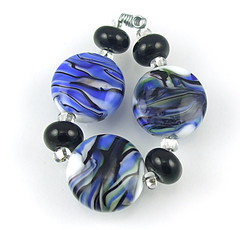What is latticino? It's a thin rod of glass that has a white (italian latte, milk) or clear base, and colored threads spiraling down the rod. Each color lasts for the full length of the latticino cane. Rainbow cane, however, is different. The color starts at one end and slowly goes through a short section of each color, each one blending slowly into the next. Here are some examples from class. We pulled a monster cane that was truly a rainbow, with colors from purple to red, and these images are the two parts of various canes:


To make any cane, first you melt the end of a long rod of white or clear. You can press it into a paddle shape or roll it into a cylinder that is somewhat fatter than the original rod diameter. Using a paddle or a barrel will change how your cane looks! Then stripe colored glass onto the paddle or cylinder, parallel to the rod.
If you want rainbow cane, make a paddle, and put the color widthwise on each side of the paddle, as if you were crossing the T relative to the upright rod. On the short edges of the paddle, lay glass parallel to the rod -- that's what makes the colors stripe one after another on the pulled cane, but keeps the black constant down the rod.
One of the lovely things about latticino is the brilliant color you can achieve. Layering a transparent color on white gives you a clarity that is unmatched. The problem is how to get the color to last throughout the cane and not get too pale and attenuated -- a couple of the ones below have inconsistent color. Generally, the thinner you plan to pull the cane, the more layers of transparent color there should be to make sure you get the depth of color you want.
Here are some of the other ones that we pulled, or that I pulled this weekend:

Now I just need to learn to USE twisties so they stay recognizeable. Mind you, they are perfectly lovely when you jumble them up, but I'd like to practice using them very precisely.
Here are some beads made with a green and blue "rainbow" latticino cane, laid on in stripes but still allowed to jumble together a bit. These are just from the blue part, but you can see the green shading in.

I think they have a bit of a Monet Iris look, but I called the set "Mexican Blanket," because the combination of the cobalt and green with the white and thin black stripe reminds me of the Mexican blankets we used to use as picnic and park blankets when I was a kid. I need to make a twistie with orange, pink, and hot green shades to complement this set.






No comments:
Post a Comment